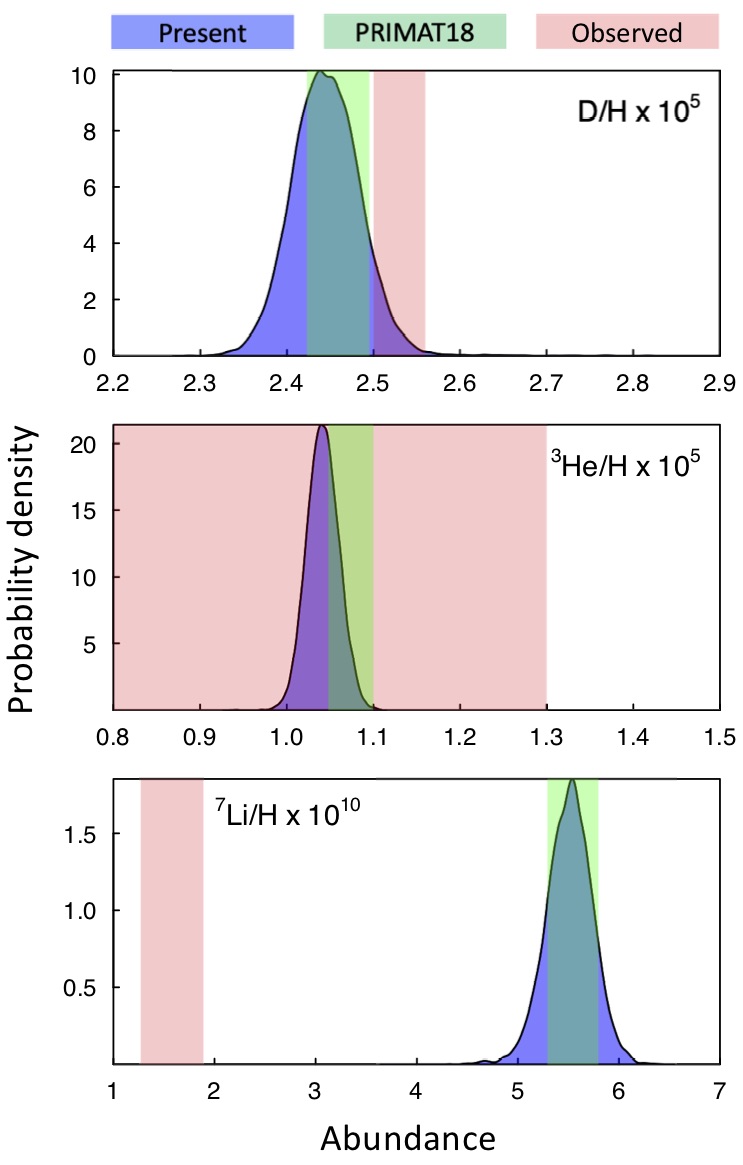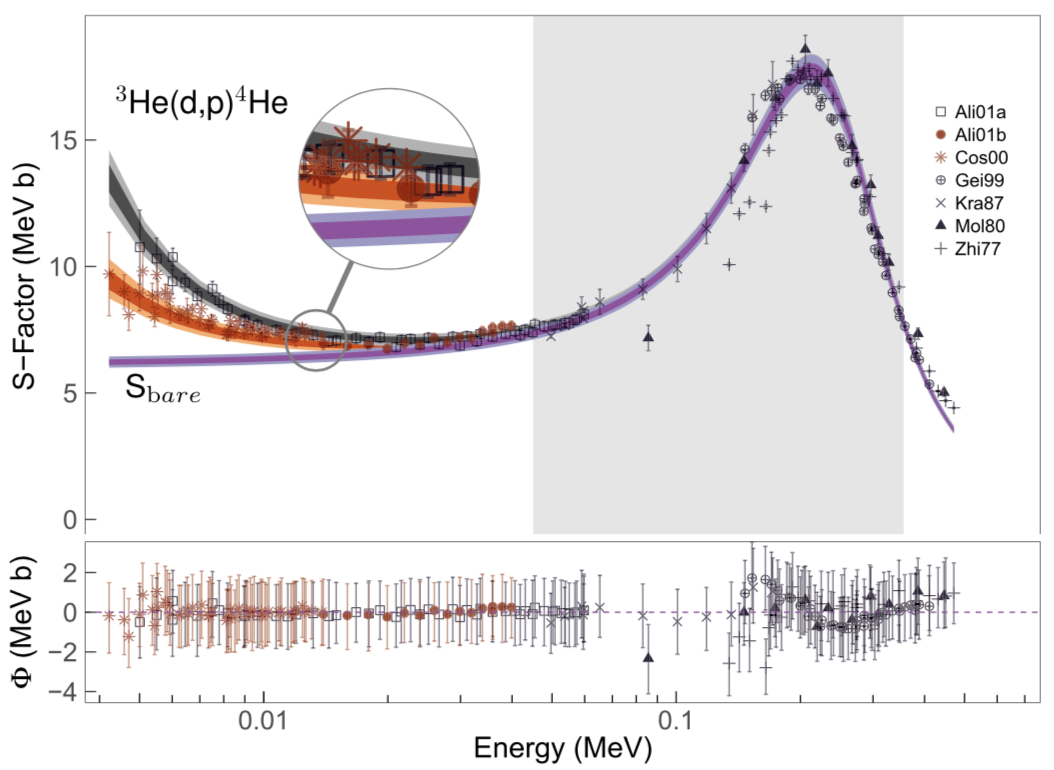Bayesian estimation of the D(p,gamma)3He thermonuclear reaction rate.
Big bang nucleosynthesis (BBN) is the standard model theory for the production of light nuclides during the early stages of the universe, taking place about 20 minutes after the big bang. Deuterium production, in particular, is highly sensitive to the primordial baryon density and the number of neutrino species. Its abundance serves as a sensitive test for the conditions in the early universe. The comparison of observed deuterium abundances with predicted ones requires reliable knowledge of the relevant thermonuclear reaction rates and their corresponding uncertainties. Recent observations reported the primordial deuterium abundance with percent accuracy, but some theoretical predictions based on BBN are in tension with the measured values because of uncertainties in the cross section of the deuterium-burning reactions. In this work, we analyzed the S-factor of the D(p,gamma)3He reaction using a hierarchical Bayesian model. We took into account the results of 11 experiments, spanning the period of 1955–2021, more than any other study. We also present results for two different fitting functions, a two-parameter function based on microscopic nuclear theory and a four-parameter polynomial. Our recommended reaction rates have a 2.2% uncertainty at 0.8 GK, which is the temperature most important for deuterium BBN.
The figure shows our Bayesian S-factor fit to the data. The two-parameter fit function was S(E) = (scale factor) × S_theory + (offset) MeVb, where S_theory denotes the theoretical S-factor calculated using a microscopic nuclear theory model. The dark- and light-gray-shaded bands correspond to 68th and 95th percentiles, respectively, of the predicted S-factor. The gray-shaded region shows the Gamow peak at a temperature of T = 0.8 GK. Residuals of fit or data with respect to the median (50 percentile) S-factor at each energy are depicted in the bottom panel. Our fit represents the most reliable estimation of the D(p,gamma)3He S-factor to date. For more information, see Moscoso, de Souza, Coc & Iliadis, Astrophys. J. 923, 49 (2021). Joseph Moscoso is a current UNC graduate student.
Thermonuclear reaction rates and primordial nucleosynthesis.
Assuming the best numerical value for the cosmic baryonic density and the existence of three neutrino flavors, standard Big Bang nucleosynthesis is a parameter-free model. It is important to assess if the observed primordial abundances can be reproduced by simulations. Numerous studies have shown that the simulations overpredict the primordial 7Li abundance by a factor of about 3 compared to the observations. The discrepancy may be caused by unknown systematics in 7Li observations, poorly understood depletion of lithium in stars, errors in thermonuclear rates that take part in the lithium and beryllium synthesis, or physics beyond the standard model. Here, we focused on the likelihood of a nuclear physics solution. Big Bang nucleosynthesis simulations were performed with the most recent reaction rates, and the uncertainties of the predicted abundances are established using a Monte Carlo technique. Correlations between abundances and reaction rates were investigated based on the metric of “mutual information.” We also employed a genetic algorithm to search for simultaneous reaction rate changes that may account for all observed primordial abundances. When the search is performed for reaction rate ranges that are much wider than recently reported uncertainties, no acceptable solutions are found. Based on the currently available evidence, we conclude that it is highly unlikely for the cosmological lithium problem to have a nuclear physics solution.
The figure compares the observed abundances (red) of deuterium (top), 3He (middle), and 7Li (bottom) with the simulated results (blue: present; green: previous). The disagreement between observation and simulation by a factor of about 3 in the bottom panel is called the “cosmological lithium problem.” For more information, see Iliadis and Coc, Astrophys. J. 901, 127 (2020).
Hierarchical Bayesian Thermonuclear Rate for the 7Be(n,p)7Li Big Bang Nucleosynthesis Reaction.
Big Bang nucleosynthesis provides the earliest probe of standard model physics, at a time when the universe was less than 1000 seconds old. It determines the abundances of the lightest nuclides, which give rise to the subsequent history of the visible matter in the universe. This work derives new 7Be(n,p)7Lithermonuclear reaction rates based on all available experimental information. This reaction sensitively impacts the primordial abundances of 7Be and7Li during big bang nucleosynthesis. We critically evaluated all available data and disregard experimental results that are questionable. For the nuclear model, we adopt an incoherent sum of single-level, two-channel, R-matrix approximation expressions, which are implemented into a hierarchical Bayesian model, to analyze the remaining six data sets we deem most reliable. In the fitting of the data, we consistently modeled all known sources of uncertainty, including discrepant absolute normalizations of different data sets, and also take the variation of the neutron and proton channel radii into account, hence providing less biased estimates of the 7Be(n,p)7Li thermonuclear rates. From the resulting posteriors, we extracted R-matrix parameters and derive excitation energies and partial and total widths. Our fit is sensitive to the contributions of the first three levels above the neutron threshold. Reaction rates were computed by integrating 10,000 samples of the reduced cross section. Our 7Be(n,p)7Lithermonuclear rates have uncertainties between 1.5% and 2.0% at temperatures of 1 GK. We compared our rates to previous results and found that the 7Be(n,p)7Lirates most commonly used in big bang simulations have uncertainties that are too optimistic.
 In the figure, above, prior and posterior densities for the R-matrix parameters of seven resonances in 7Be(n,p)7Li are compared. New information from our fitting is obtained for the first three resonances for which the posterior is significantly narrower than the prior. For more information, see de Souza, Tan, Coc and Iliadis, Astrophys. J. 894, 134 (2020). Rafa de Souza was a former UNC postdoc.
In the figure, above, prior and posterior densities for the R-matrix parameters of seven resonances in 7Be(n,p)7Li are compared. New information from our fitting is obtained for the first three resonances for which the posterior is significantly narrower than the prior. For more information, see de Souza, Tan, Coc and Iliadis, Astrophys. J. 894, 134 (2020). Rafa de Souza was a former UNC postdoc.
Astrophysical S-factors, Thermonuclear Rates, and Electron Screening Potential for the 3He(d,p)4He Big Bang Reaction via a Hierarchical Bayesian Model.
We developed a hierarchical Bayesian framework to estimate S-factors and thermonuclear rates for the 3He(d,p)4He reaction, which impacts the Big Bang abundances of 3He and 7Li. The available data were evaluated and all direct measurements were taken into account in our analysis for which we can estimate separate uncertainties for systematic and statistical effects. For the nuclear reaction model, we adopt a single-level, two-channel approximation of R-matrix theory, suitably modified to take the effects of electron screening at lower energies into account. In addition to the usual resonance parameters (resonance location and reduced widths for the incoming and outgoing reaction channel), we include the channel radii and boundary condition parameters in the fitting process. Our new analysis of the 3He(d,p)4HeS-factor data results in improved estimates for the thermonuclear rates. This work represents the first nuclear rate evaluation using R-matrix theory embedded into a hierarchical Bayesian framework, properly accounting for all known sources of uncertainty. Therefore, it provides an important test bed for future studies of more complex reactions.
The figure shows credible S-factors, which resulted from our Bayesian model. At low energies, the upper two lines include the effects of laboratory electron screening. The lower line, labeled “S_bare”, provides the important information to compute the thermonuclear rate at Big Bang temperatures. For more information, see de Souza, Iliadis & Coc, Astrophys. J. 872, 75 (2019) and de Souza et al., Phys. Rev. C 99, 014619 (2019). Rafa de Souza was a former UNC postdoc.



